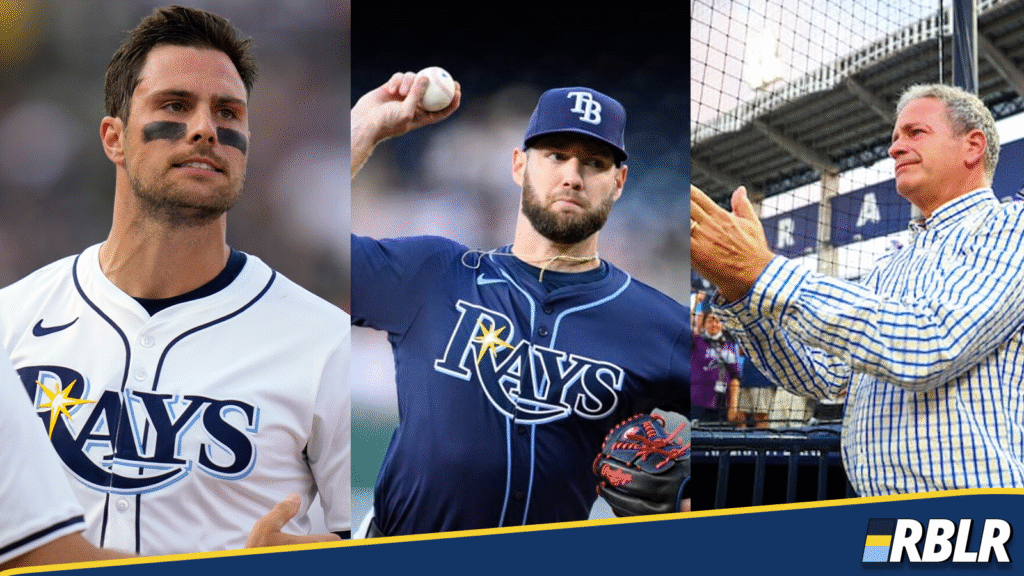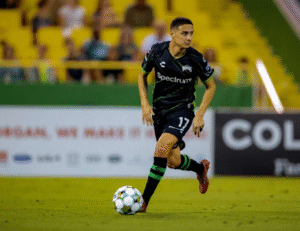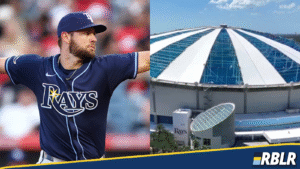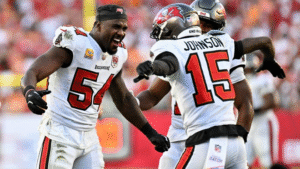RBLR Rays Roundtable #32 – Roster Rounding, Bouncing Back, & Stu’s Farewell

This week our writers explored whether or not Adrian Houser should be brought-back in free agency, where the depth fell short this year, and reasons to believe in a Josh Lowe resurgence in 2026. Lastly, we wrapped it up with a reflection on Stu’s tenure with the Rays pending the alleged sale of the team this offseason.
Jacob Macauley (@raysfarmreport) : #ExtendHouser
I was initially rather critical of the acquisition of Adrian Houser at the trading deadline, given his subpar peripheral metrics and the price the Rays parted with for a rental starting pitcher of the caliber I initially perceived Houser to be, but getting the opportunity to track Houser closer, I think it’s in the Rays best interest to extend the veteran right-hander.
With the Rays so far, Houser has posted a 14.1% K-BB% (Up 5%), and is running a 54.1% Zone% (65th percentile amongst qualified starters) with Tampa Bay. Upon arrival to the Rays, Houser’s biggest Achilles heel was his inability to get left-handed hitters out. Houser posted poor marks vs left-handed hitters (5.6% K-BB% and a .354 wOBA) in his time with the White Sox, but with the Rays, he’s made a marginal improvement to his wOBA allowed (.347), and a significant improvement to his K-BB% (12.6%). Why the sudden improvements? The Rays have drastically increased Houser’s slider usage rate vs lefties from a 3% usage pitch up to a 17.5% in September. Why is this important? It’s a pitch he has a solid ability to zone, as he is in the zone with his slider 41% of the time, versus the curveball, he has cut back on that was just landing in the zone 33% of the time. The slider also provides a pitch to keep a left-handed hitter honest, as he can split the plate more effectively. With these in-season improvements and willingness to adapt to improve his peripheral metrics, while his baseline performance was plus, this is a no-brainer decision in my mind to bring Houser back for the 2026 campaign.
Jake Shutters (@JakeShutters) : Depleted Depth
The Rays obviously are wrapping up a severely underwhelming season, being eliminated from the postseason hunt last weekend and staring down the barrel of a second straight losing season after their run of consistent success from 2018-2023. Many questions will need to be asked about the state of the organization and where the future will head, especially under a new ownership group, but the simplest question one could ask is “What was the difference between this year’s group and groups of years prior?” One of those answers, in my opinion, was a lack of lineup depth that was there in the postseason streak.
In 2025, the Rays have currently four hitters with a wRC+ greater than 100, those being Jonathan Aranda, Yandy Diaz, Brandon Lowe, and Junior Caminero. Aside from those 4 names, which was essentially the entirety of the main core of the position player group, no one else was above league average at the plate. 2019 saw 10 hitters with over a 100 wRC+, 2020 saw 9 (min. 50 PAs due to the shortened season), 2021 had 11, 2022 had 9, and 2023 had 10. The Rays wouldn’t have win games on the backs their high end talent due to names like Manuel Margot, Luke Raley, Harold Ramirez, Joey Wendle, and Ji Man Choi all performing well in their roles and in the position they would typically excel at. In my opinion, a re-evaluation of the offensive depth would do wonders for the 2026 Rays and allow them to go back to exploiting matchups and putting players in the best position to win, something they excelled at between 2019-2023.
Dustin Teuton (u/FLBoy19) : Betting on Josh Lowe
IQR, or interquartile range, is a stat used to measure variability, capturing the middle 50% of outcomes in a dataset. Baseball projection systems often use a version of this, typically showing 20th and 80th percentile outcomes. While projections like ZiPS rely on historical data from comparable players, most guys usually end up somewhere in that 60% band. An outcome in the other 40% is not considered an outlier, but would be considered highly unlikely production.
Josh Lowe’s 2025 season statistically can’t be considered an outlier, but has been a highly unlikely outcome. The Rays have had 12 hitters clear 200 plate appearances this year, and only two have seasons that fall over .6 fWAR outside their ZiPS projections—Junior Caminero and Josh Lowe. Caminero blew past expectations with a 4.2 fWAR after ZiPS projected 0.41–3.19. Lowe has gone the opposite direction: his 0.2 fWAR lags badly behind his projected 0.91–3.4. He was supposed to be at worst a big platoon bat and at best a borderline star.
And that’s where the confusion sets in. Offensively, the only real negative regression is a 4% drop in barrel rate from 2024, 4.7% down from his breakout 2023. His walk rate has actually ticked up by 1.4%, and his strikeout rate has been stable at 24.9% (24.8% in 2023, and way better than the 31.8% he posted in 2024). His zone-contact rate sits at 79.8%, right in line with the 80–81% range from past years. His chase rate is only slightly worse (36.6% vs. ~35% the past two years). Even his called-strike-plus-whiff rate has improved. The stat that jumps off the page is his .282 BABIP, way down from .357 in 2023 and .338 in 2024.
But BABIP doesn’t fully explain it either. Lowe is hitting more line drives than ever (24.3%), which should help. Instead, his fly-ball rate has cratered from ~40% the past two years to just 29.2%. That’s pushed his ground-ball rate nearly 7% above his career norm. More line drives and grounders should lead to better outcomes, not worse. Even his extra-base-hit rate per plate appearance hasn’t fallen off a cliff—12.3 PA/XBH this year compared to 12.4 last year, though still worse than 2023. His hard-hit rate and exit velocity remain steady. The only real red flag is a 4.7% decline in “fast swings” (swings over 75 mph). That drop has lined up with a 3% decrease in blast percentage—those high-quality contact swings that usually do massive damage.
So why is this season such an outlier? A big part of it is health. Repeated oblique injuries linger and sap explosiveness, and Lowe has now dealt with them multiple years in a row. That’s likely taken some of the A-swing we saw in 2023 out of his game. Back then, he was getting to 76+ MPH swing speed nearly 18% of the time. Even in 2024 he reached that level more often than he has this year. Without that explosiveness, his contact looks similar based on basic batted ball data, however doesn’t have the same borderline elite impact seen in 2023.
At the end of the day, Lowe’s season feels like the product of both bad luck and poor injury luck. The Rays will almost certainly emphasize flexibility and core strength training for him this offseason to finally break the oblique cycle. If he can stay healthy into 2026, he’ll still be in the middle of his prime and absolutely capable of a 3.5–4.0 fWAR season. Personally, I still believe he has that in him—it just comes down to health and getting back to the A-swing that made him special in 2023.
Sandy (@SandyAndTheRays) : Farewell Stu
The Rays wrapped up their final homestand of the season after being eliminated from playoff contention in Friday’s game against the Red Sox. That marks two straight seasons without October baseball—a rare outcome for a team that’s been a fixture in the postseason for much of the last decade.
Amid that disappointment came a farewell to Stu Sternberg at Saturday’s game. The Rays played a tribute video and had team employees tip their caps to him during a break in the second inning. In some ways, it made sense—Sternberg is stepping away after nearly 20 years of ownership, and this final homestand was the natural moment for a sendoff.
Still, the reception among fans tells a different story. Sternberg has long been a polarizing figure, and this season was especially tumultuous, with stadium negotiations collapsing and trust between the organization and the community at another low point. Scrolling through replies to the Rays’ social media posts reveals just how mixed (or negative) fan reactions were. Fans haven’t forgotten his repeated relocation threats, his unwillingness to invest in keeping top players, and his limited engagement with the community. For many, the farewell wasn’t “thank you” so much as “good riddance.”
To be fair, Sternberg did leave behind one important legacy: a winning culture. During his tenure, the Rays became consistent playoff contenders, reaching the playoffs nine times since 2008, winning four American League East division titles, and capturing two AL pennants. That success changed the way the franchise is viewed across baseball, underscoring just how unusual it is for the Rays to miss the playoffs.
Now it’s on the new ownership group to restore momentum, rebuild trust, and—hopefully—carry the Rays to the next level.
The RBLR Rays Roundtable is a weekly collection of analysis, insight, and perspectives from a cast of writers assembled because of their unique backgrounds and experience. Check this space weekly for new updates and features covering the Tampa Bay Rays, the Rays’ minor league prospects, and more!







